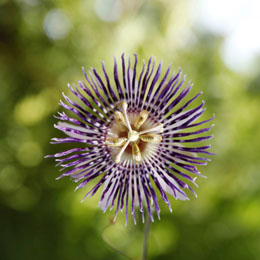Purple passion flowers are strongly associated with passion and permissiveness because of their subtle purple color. There are numerous species of purple flowers, some of which are shrubs and some vines.

Also known by the scientific name of
passiflora incarnata, the purple passion vine is a semi-tropical vine that is popularly cultivated all over the world with great pursuit. There are more than 500 species of the purple passion flower, some of them bearing edible fruits. The vine is also grown as a medicinal plant for its use in treatment of insomnia and as a sedative in many nervous disorders. It is sometimes also called as
Maypop. It contains small berrylike flowers, that are known as
Granadilla.
The flower is also associated with certain Christian beliefs related to crucifixion and romance. It is said that the purple color made the pilgrims aware of the passion and sufferings of Jesus Christ. Cultivation of this vine, as an outdoor decorating plant, has boomed in the recent years. It is vastly seen in patios of houses and is also a perfect plant for hanging baskets.
Purple Passion Flower Vine
Kingdom
Plantae
Division
Magnoliophyta
Class
Magnoliopsida
Subclass
Rosidae
Order
Malpighiales
Family
Passifloraceae
Genus
Passiflora
The purple passion flower vine is an ornamental plant, that really helps in enhancing the exterior ambiance of a house. These flowers are found in tropical American regions like Mexico, Venezuela, Brazil, and Peru. Some of them are scented and are used for making perfumes. The flowers are pink, lavender to bright purple in color with a mild fragrance that attracts many birds. It is a must plant for any butterfly garden. Gardening the vine is easy, if you know the basic characteristics of the plant.
Emplacement and Light
The vine requires a partly shady to full sunny environment but, not extremely strong sunlight. So, the best suggestion is to provide them with partial shade. This vine grows very fast and sprawls across. So if you want to cultivate them outdoors, make sure you plant them on trellis and near some chain link fences, rock gardens, or at least a concrete surface. Certain species of the passion vines are best suited to be planted indoors as container plants. The areas that have plenty of sunlight and humid environment provide best conditions for the growth of the vines.
Soil and Moisture
It requires an average amount of water on a regular basis. Make sure that the plant has soaked up all the water before watering it again. The soil pH must be mildly alkaline, mildly acidic, and most preferably neutral. While planting the vine use,
2 parts of peat moss mixed in 2 parts of loam + 1 part of sand.
Fertilization and Repotting
The vines require fertilization on a regular basis, most probably every 30 days. Use a good quality fertilizer that has a pH balance somewhere between 2-1-3. As stated earlier, the purple passion flowers are extremely fast-growing plants, hence they require yearly repotting, preferably during September, which is the start of their growing season. During the winters, the water schedule must be adjusted according to the temperature in your area. The purple passion vines generally hold on for a long time to the water with a temperature of 9°C. Trimming the leaves is very important during the onset of spring season.
Propagation and Seed Collection
Purple passion flower vines are propagated by the division of the offsets, cuttings, and from seeds sown directly in soil or simply by soil layering. For sowing the seeds, remove the fleshy part off the seed and let the seed dry completely before sowing it. They yield better results when propagated in fall. The passion fruits appear after the first 2-3 months of flowering, the fruits are yellowish and soft. Fully matured seeds are brown in color and they must be cleaned as soon as possible. To enhance the bushy structure of the vine, make ridges around the plant, in its first flowering season.
If you are buying the plant from the market, then make sure you pick up the plant that has a clear and healthy foliage and good roots. Also remember that the ingestion of some parts of the vines can be toxic, especially to the pregnant women.
Purple passion flower vine is a great ornamental plant if you are trying to glorify your flower garden.






 Also known by the scientific name of passiflora incarnata, the purple passion vine is a semi-tropical vine that is popularly cultivated all over the world with great pursuit. There are more than 500 species of the purple passion flower, some of them bearing edible fruits. The vine is also grown as a medicinal plant for its use in treatment of insomnia and as a sedative in many nervous disorders. It is sometimes also called as Maypop. It contains small berrylike flowers, that are known as Granadilla.
Also known by the scientific name of passiflora incarnata, the purple passion vine is a semi-tropical vine that is popularly cultivated all over the world with great pursuit. There are more than 500 species of the purple passion flower, some of them bearing edible fruits. The vine is also grown as a medicinal plant for its use in treatment of insomnia and as a sedative in many nervous disorders. It is sometimes also called as Maypop. It contains small berrylike flowers, that are known as Granadilla.